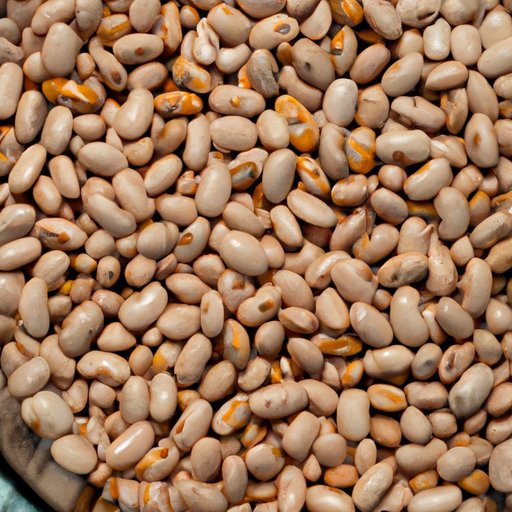
I. Introduction
Cooking dried beans can be a daunting task for many. Too often, people face the issue of beans that are either undercooked or overcooked, resulting in a less-than-desirable texture and taste.
In this article, we’ll walk you through the process of cooking dried beans step by step to guarantee perfectly cooked and flavorful beans that can be used in various recipes. Whether it’s for a hearty bowl of chili, a veggie burger, or a salad, cooking dried beans at home is a cost-effective way to add a healthy and sustainable source of protein to your diet.
II. Master the art of cooking dried beans: A step-by-step guide
Before diving into the actual cooking process, it’s essential to understand the basic steps involved in cooking dried beans.
The process can be broken down into three main stages:
- Pick the right type of bean and remove any debris and dirt
- Soak the beans overnight or use a quick-soak method
- Cook the beans until tender
When it comes to choosing the right type of beans, it’s essential to consider the dish you’re making. Different beans have unique characteristics, flavor profiles, and cooking times, making some better suited for specific dishes than others. For instance, black beans are ideal for Cuban dishes, while chickpeas are perfect for hummus.
Step-by-step instructions for cooking dried beans:
- Sort and rinse the dried beans under running water, removing any debris and dirt.
- Soak the beans overnight in a large bowl or pot with enough water to cover them.
- Once the beans have soaked, drain the water and rinse them again.
- Place the beans in a large pot, cover them with water or broth, and bring to a boil.
- Reduce the heat and let the beans simmer for 1-2 hours or until they are tender.
- Drain any excess liquid and season the beans with salt, pepper, and your preferred spices.
III. The perfect boiled beans: Tips and tricks for achieving the ideal texture
When boiling beans, common problems include overcooking, causing them to get mushy, or undercooking, leaving them hard and chewy. However, the ideal boiled beans should be tender but not mushy, allowing them to retain their shape and texture.
Here are some tips and tricks to help you achieve your desired texture:
- Use fresh beans. The longer the beans are stored, the drier they become, leading to uneven cooking and an unpleasant taste.
- Don’t add salt until the beans are cooked. It’s a common misconception that adding salt to the water while cooking will improve the flavor, but it actually hardens the beans’ skin and prolongs the cooking time.
- Use enough liquid. Make sure the beans are completely submerged in water or broth to ensure they cook evenly.
- Simmer, not boil. Boiling the beans can cause their skin to split, leading to uneven cooking and a mushy texture.
IV. From soaking to simmering: The complete process of cooking dried beans
Soaking is an important pre-cooking step when it comes to cooking dried beans. It reduces the cooking time, minimizes the gas-causing compound, and helps to achieve a tender texture.
Here’s how to soak and simmer beans:
- Sort and rinse the dried beans under running water, removing any debris and dirt.
- Soak the beans overnight or use the quick-soak method. For quick-soak, place the beans in a pot and add enough water to cover. Boil for 2-3 minutes and remove from heat. Cover and let soak for an hour.
- After soaking, drain, and rinse the beans under running water.
- Place the beans in a pot and cover with water or broth.
- Bring to a boil then reduce heat to a simmer.
- Simmer for 1-2 hours or until the beans are tender.
- Season with salt, pepper, and your preferred spices.
V. Creative ways to use cooked beans in your recipes
Cooked beans are versatile ingredients that can be used in numerous recipes, making them an excellent pantry staple for any kitchen. Here are some ideas for incorporating cooked beans into your everyday dishes:
- Add to salads for an extra protein boost.
- Make homemade hummus or bean dip.
- Add to soups, stews, and chili to bulk up the dish and add more flavor.
- Use as a substitute for meat in burgers, tacos, and burritos.
- Add to pasta dishes for a vegetarian twist.
VI. Discovering new flavors: How to season your cooked beans for a delicious meal
Beans are a blank canvas when it comes to seasoning and can work with many different flavor profiles. Basic seasoning options include salt, pepper, garlic powder, and lemon juice. However, if you want to mix things up, here are some creative seasoning and spice combinations you can try:
- Cumin and chili powder for a Southwest-inspired flavor
- Curry powder and paprika for a bold and spicy taste
- Oregano and thyme for a classic Mediterranean flavor
- Ginger and turmeric for an Asian-inspired twist
- Garlic and rosemary for a fragrant and savory taste
VII. Conclusion
Cooking dried beans may seem intimidating at first, but with a little bit of practice, it can be a rewarding and sustainable way to add protein to your meals. Remember to pick the right type of bean, soak properly, use enough liquid and cook to your desired texture, and season to your taste. With these tips and tricks, you’ll be able to master the art of cooking dried beans.
So, go ahead and try to cook dried beans at home.





